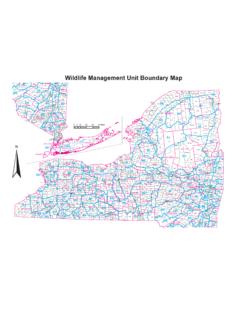Transcription of Harsens Island / St. Clair Flats Historical Society
1 Welcome Aboard! Take a trip from Detroit to the hotels in the St. Clair Flats and Harsen s Island on steamers of the White Star Line Circa 1900 to 1936 Harsens Island / St. Clair Flats Historical Society The Entrance to The Flats Map shows the entrances to the South Channel of the St. Clair River. Earliest channel is the old South Channel guided by the lighthouse and beacon, circa 1859, known as the South Channel Range Lights. Later in 1871 the Ship Canal was built be-cause of the shallow water. The Piers as they were also known, were constructed to kept the silt from washing in again. On each end of the North bank twin lighthouses were constructed. Willow trees were planted on both the North and South banks. South Channel Lights also known as the South Channel Range Lights Three views of the South Channel lighthouse and beacon, ca.
2 1900. Photographs courtesy of the Save Our South Channel Lights Association. South Channel Range Lights 1859 Steamer Tashmoo entering the Ship Canal. Twin lighthouses were constructed on the North bank at the lower and upper ends. Note: Lighthouse at lower entrance of the Pier s. This view (lower entrance) of the Ship Canal shows one of the twin lighthouses on the North bank. On November 15, 1871 the twin lighthouses were lit. In an article Let the Lower Lights Be Burning: A History of the Lighthouses at the St. Clair Flats by Cynthia S. Bieniek, published in Tonnancour, Volume 2, she states: The towers were octagonal red brick with cut stone bases. The keepers houses were built of red brick with slate roofs and green window blinds. Each dwelling had ten rooms and water was piped from the lake to a hand pump in the kitchen sink.
3 A white boathouse, red painted oil house, and whitewashed chicken coop completed the scene. The lighthouses were accessible only by boat. SHIPS E1 TERI1G THE U. S. SHIP CA1AL ALSO K1OW1 AS THE PIERS A1D THE ST. Clair SHIP CA1AL 1871 ST. Clair Flats THE VE1 ICE OF AMERICA Excursion steamers entering the St. Clair River after trav-ersing the Ship Canal. This view would be from The Old Club. The U. S. Ship Canal 1859 1871 Caption: Freighter in the Ste. Claire Ship Canal Caption: Passenger Steamer in the Sainte Claire Ship Canal Caption: Steamer Midvale in the St. Clair Ship Canal Enlarged map showing entrances to the South Channel Caption: Steamer Tashmoo in the Ship Canal HISTORY OF PIERS LIGHTHOUSE RECORDED Helen Yacques, an old timer submitted the fol-lowing information on the piers. I spent six rather exciting weeks back in 1922 at the lighthouse that stood on the piers.
4 Mr. Tom Lapin was the keeper of the light, which was lit at sundown, and put out each morning. It was a guiding light for freighters which came up from the lake on one side and down on the other. Mr. Lapin s wife was dying in Detroit, so my husband was asked to take over for awhile. To light the lamp you ascended a circular iron stair-way and it didn t pay to look down. The first day we were there a cruiser caught fire and two people drowned. A passing freighter told us to rescue them. It was next to impossible to launch our small boat as the waves were so high but we did it. The second day we were there, a small government boat stopped by on a routine checkup and I learned that baby clothes (we had our first child along) were not to be seen and things must shape up or ship out. You learn faster in your 20 s.
5 I ve written to the Corps of Engineers for information on the piers as most people don t remember about them. Gull Island is all that remains. Respectfully submitted: Helen Yacques an old timer FIRST STOP THE OLD CLUB Founded in 1872 as the Lake St. Clair Fishing and Shooting Club, the original building was first located on the opposite side of the river from its present site at the south end of the St. Clair River. In 1887, Walter MacFarlane, architect, designed the building shown on the left completely sheathed in shingles. The purpose of this building was to satisfy the desire for a more acceptable environ-ment for social occasions for the most influential Detroiters of the day. In 1902, the name was for-mally changed to The Old Club.
6 In the spring of 1926, the building was destroyed by fire and in the fall of the same year, construction was started on the present clubhouse building. SECO1D STOP HOTEL MERVUE Special weekly rates of $ , 50 bedrooms. Meals served to the general public. Frog, fish, steaks, chops served a la carte. Slot machines. Regular Launch service to any part of the Flats 25 cents. Free dancing on the largest dance floor on the Flats . Considered by many in its heyday to be one of the most unique summer resorts in the world. Hotel Mervue was also known as the New Mervue Club, Hotel Gorman Millers Hotel, Four Winds was the original dance floor of the Hotel Mervue. The rest of the hotel was torn down in the 1940 s. The Four Winds building is now the sec-ond floor of a private residence owned by Gregory Kiesgen. The sunsets are outstanding!
7 THIRD STOP RUSHMERE CLUB Few facts can be found concerning the Rushmere Club as it was one of the first large hotels on Har-sen s Island to burn down. This happened on Au-gust 29, 1908. There were no phones, roads, or fire department. As with most of the clubs and hotels, the Rushmere had its own small vegetable and fruit farm and served delicious fish and fowl dinners. Today the property is residential. and is a favorite area for scuba divers looking for relics of the past. FOURTH STOP STAR ISLA1D HOUSE Established in 1875, proprietor James Slocum. Skilled punters, large roomy verandas, sail boats, row boat, steam and gasoline launches, large basin in the center of the grounds containing specimens of fish and wild water fowl. 1/3 mile bicycle track encircled by running waters, lawn tennis and cro-quet grounds, bird shooting, billiards, bowling and dancing, 150 rooms, 500 capacity dining room.
8 $2/day, Star Island House was built by the White Star Line to introduce the middle class element to the Flats area. Today it is a residential property. HOTELS I1 THE ST. Clair Flats A1D HARSE1 S ISLA1D THE1 A1D 1OW FIFTH STOP MARSHLA1D CLUB Built as a private hunting and fishing club, the Marshland Club had 38 rooms plus a large dining and dancing area. The Red House was a bar which sat behind the main building and many an afternoon was spent drinking and playing cards on the porch. The Marshland burned down in 1929 and in 1931. SIXTH STOP RIVERSIDE This hotel was run by a Mrs. Gadd and was much smaller than it is today. It be-came Club Aloha when a Mr. Herman brought it. Then the portion of the building from the lobby going upriver, including the charming bar were added on and it became a well known steak house.
9 The govern-ment leased it during World War II to use as a barracks. Today this hotel is known as the Idle Hour Yacht Club. SEVE1TH STOP KEHL S PUBLIC HOUSE The restaurant, bar and large round dance pavilion were located upstream from the present building which was the hotel part with approximately twenty rooms. When William P. Forester was proprietor, the cost was $ and meals 50 cents. Known for its hunting and fishing it was originally Kehl s Public House, St. Clair Island House at Willow Grove, Trautz s, Forester s, Kulow s Seaway, 4-B s, Jacob Harsens Boat Harbor Club and currently South Channel Yacht Club. HOTELS I1 THE ST. Clair Flats A1D HARSE1 S ISLA1D THE1 A1D 1OW EIGHTH STOP JOE BEDORE S The original building was on the Cana-dian side of the river.
10 Joe Bedore was pro-prietor and host extraordinaire. His hotel became the most famous of all the water-side road houses between Erie and Huron. $ , meals 50 cents, dancing pavil-ion, marvelous meals and stories. Thirty rooms, slot machines, closed in the 1950 s. 1I1TH STOP MUIR HOUSE The Muir family came to the Flats in 1880, when Mr. Muir became the manager of the St. Clair Flats Shooting Co. Canada Club. The Muir Family later built their hotel across the river, but it was not long after the hotel was established the senior Muir s passed on and left Charlotte to care for her three young brothers. Muir Hotel provided no bar facilities. It was known as the hotel where single women were to feel at home. TE1TH STOP MAPLE LEAF The Maple Leaf was a dock used by the White Star Line to drop off some of the 22,500 visitors and 100,000 cottagers who came to Harsen s Island every summer in the late 1800 s and early 1900 s.





